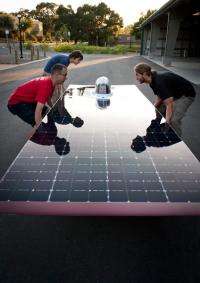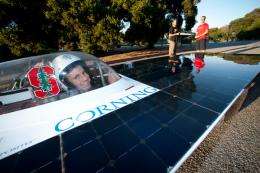Powered by the sun, Stanford ingenuity

On Thursday, Aug. 11, the Stanford Solar Car Project officially unveils Xenith, a solar-powered vehicle two years in the making that boasts several industry-leading technological innovations. The team will be competing in the prestigious World Solar Challenge this fall, putting Xenith to the test in a 2,000-mile race across the Australian continent.
"The plan is to win," said Nathan Hall-Snyder, a member of the Stanford team that has designed and built a solar-powered car that will race against some of the fastest student-built solar cars in the world.
Dubbed the "Fearless Leader" by teammates, Hall-Snyder is the president of the Stanford Solar Car Project, a group of undergraduates dedicated to building and racing solar-powered vehicles. In October, after two years of hard work on their latest creation, Xenith, the team will be heading to Australia to compete in the World Solar Challenge, held every two years.
The team will be on hand at 5 p.m. Thursday for the public unveiling of the car on the Stanford campus, at the Volkswagen Automotive Innovation Laboratory.
Hall-Snyder, who joined the Solar Car team as a freshman, has some unfinished business to take care of. In 2009, the Stanford team finished a respectable 10th of 25 entrants, but was last out of the cars that actually finished the race (15 teams dropped out). So it was back to the drawing board for Hall-Snyder and his crew – and this time around, they're going for the gold.
Those 'crazy Californians'
At most hours of the day – and practically all hours of night – students can be found laboring in the Volkswagen Automotive Innovation Laboratory, a state-of-the-art design and manufacturing facility on the outer edges of the Stanford campus.
"This year we focused on designing the most aerodynamic shell possible, and then designed everything else to fit inside," said Hall-Snyder.
Tipping the scales at just 375 pounds, Xenith has a 4-inch thin chassis and is made of a unique blend of carbon fiber, titanium and aluminum. A novel three-wheel steering system was also developed; the driver controls the front wheel while a computer steers the two back wheels.
The result is a spaceship-like vehicle that creates less aerodynamic drag than a rider on a bicycle – not bad for a racecar that can cruise continuously at over 55 miles per hour fueled only by the sun.
Xenith runs on the most efficient motor in history, says mechanical team leader Paul Karplus, a mechanical engineering major. The new motor, which boasts an unprecedented 98 percent efficiency, was designed and built specifically for the solar car.

The solar panels powering Xenith may be the most innovative components of the car. Not only are the silicon solar cells, provided by sponsor SunPower, some of the best in the industry, but the team has built a revolutionary encapsulation for the cells.
"We are the first team we know of that is using thin, flexible glass," said the team's financial manager, Theodore Wesley Ford, an economics major. "The glass gives us a big advantage because of its strength, UV stability and optical clarity."
Unsatisfied with the plastics and polymers typically used for solar cell encapsulation, Ford and teammate Paul Chen, a computer science student, sourced and tested numerous materials before striking gold – a new prototype glass developed by one of the team's sponsors, Corning.
"This glass doesn't absorb the areas of the spectrum where silicon solar cells get energy," said Chen. "It's as if the cells are sitting bare under the sun."
"Xenith is an epitome of the Stanford philosophy of 'think outside the box,'" said Ian Girard, a grad student in mechanical engineering. "People think our car is going to explode – that we're crazy Californians, because it looks nothing like any other car."
From engineering exams to real engineering
Collectively, Ford estimates that the team has invested over 10,000 hours into the construction of the car, with many more to come before and during the race. The current cost of the car is roughly $500,000.
During the school year, late-night work sessions are common, including one marathon 45-hour session to "bake" the composite body of the vehicle. This summer, most of the students are working full-time internships elsewhere but spend nights at the shop and share a house in Palo Alto.
As a result of this immersive involvement, the Solar Car project has had significant impact upon their academic and career plans.
Chen, who joined the team during his freshman year as a chemical engineering major interested in making solar cells, discovered a passion for coding while working on the car.
"Solar Car definitely influenced my decision to switch majors to computer science," he said.
The opposite happened to Nathan Golshan, a product design major. Although he entered Stanford with plans to major in computer science, building the brake and accelerator pedals for Xenith brought out the mechanical designer in him.
"Like every good engineer, I played with Legos for most of my childhood," he said. "I realized partly through Solar Car that I missed building things and working with my hands."
Out into the world
After all, as Golshan points out, Solar Car offers a hands-on engineering opportunity that is virtually unparalleled and provides a great complement to Stanford's academic offerings.
"Stanford gives you an excellent theoretical education, but Solar Car is one of the only places on campus that you can practice that," said Golshan. "Between this past year and the summer, I have learned more here [at the shop] than any class."
Rachel Fenichel, working toward a computer science degree, experienced engineering on an unusually personal level this year. As one of the few team members small enough to fit into the compact vehicle, she will be doing much of the driving for the World Solar Challenge, and she also programmed the driver controls and the rear wheel steering system.
"There's a lot more at stake in my code," said Fenichel. "There's a big difference between a class, where you have an assignment … and a project like this, where you have to keep the driver safe at all times."
But despite the high pressure and sometimes grueling hours, Solar Car team members are an enthusiastic, passionate bunch. "If you fail at something, one of the things you hear all the time is 'if you fail, try harder,'" said Golshan. "This is what makes Solar Car awesome."
There are no requirements for joining the team, other than time commitment and a willingness to learn. Older students typically provide a great deal of mentoring, and there is room for experimentation and creativity. As a result, many technological breakthroughs have been made and several startups created over the years.
"Any electric car you can buy has technology that was probably developed at Solar Car," said Hall-Snyder. For example, the founders of Tesla Motors included a core group of Stanford Solar Car members.
"It's an opportunity to test technologies that can help the world," said Girard. "[We] figure out which ones work and which ones don't. It's a test bed between the laboratory and the real world."
Ready, set, go!
For the 20 team members heading off to Australia for this year's 11th World Solar Challenge, the next few months will be the thrilling and tumultuous end to a long journey.
They will be racing against 30 other highly competitive teams, including cars from 20 countries, the University of Michigan, MIT, and the University of California-Berkeley. An American team has not won the race since 1987.
To fund the project, Ford and his teammates have sought the support of major sponsors, including Stanford University and Volkswagen, as well as more than 30 companies who receive benefits ranging from networking to logo placement on the car. The team is currently trying to raise a final $26,000 to cover race costs, including living expenses for the five weeks in Australia.
During the race, team members will be providing updates to friends, family and fans via their blog and YouTube channel. There is a great deal of work that remains to be done, and there will likely be technical difficulties and unexpected obstacles along the way, but the team is revved up and ready to go.
After all, what could be more exciting than racing across the Australian Outback in a solar car built by you and your friends to test the limits of modern technology?
"We're very excited to see kangaroos," said Girard. "As long as they're not in front of the car!"
Provided by Stanford University


















